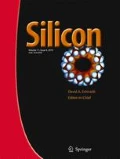Abstract
The UV absorption spectra of polyhydrosilanes are investigated with the purpose to obtain a model that correlates specific aspects of the electronic spectra to the polymer chemical structure. For this purpose polysilanes with a well defined chemical structure were synthesized in similar reaction conditions. UV investigations have been carried out to obtain the profile of the synthesized polysilane electronic spectra and identify the effects induced by both structural and conformational changes. Molecular modeling calculations were then correlated with the experimental results in order to connect the electronic system to the polysilane structure. Such a method is useful to study polysilanes with complex structures where parts of the polymeric architecture should have a specific influence on the conjugated electrons system.
Similar content being viewed by others
References
Katiyar M, Sharma A, Deepak (2006) Organic ultraviolet light emitting diodes, New Delhi, p 24–89
Krempner C (2012) Polysilane dendrimers. Polymer 4:408–447
Sacarescu G, Simionescu M, Sacarescu L, Mantu D, Mangalagiu I (2009) Polyhydrosilanes – new materials with NLO properties. Acta Chemica Iasi 17:121–135
West R (1986) The possibility of synthesis of alternative copolymers composed of oxyhexakis(dimethylsilylene) units. J Organomet Chem 300:327–346
Miller RD, Michl J (1989) Polysilane High Polymers. Chem Rev 89:1359–1410
Takao I (1999) Excitation and detection energy dependence of the fluorescence of polysilanes in dilute solutions. J Inorg Organomet Polym 9:245–252
Sacarescu L, Simionescu M (2008) Polymer route for silicon quantum dots. J Optoelectron Adv Mater 10:649–653
Jang SH, Park CK, Song YS, Lee GH (1996) Syntheses and characterizations of polysilanes with bulky subsituents. Bull Korean Chem Soc 17:443–447
Kamata N, Terunuma D, Ishii R, Satoh H, Aihara S, Yaoita Y, Tonsyo S (2003) Efficient energy transfer from polysilane molecules and its application to electroluminescence. J Organomet Chem 685:235–242
Sacarescu L, Bockholt A, Siokou A, Simionescu M, Sacarescu G (2009) Structural and optical properties of polyhydrosilanes. Macromol Chem Physic 210:2015–2021
Jones RG, Benfield RE, Cragg RH, Swain AC, Webb SJ (1993) Evaluation of the synthesis of polysilanes by the reductive-coupling of dihaloorganosilanes. Macromolecules 26:4878–4887
Tarabukina E, Krasova A, Filippov A, Sacarescu L, Simionescu M, Sacarescu G, Soroceanu M, Harabagiu V (2013) Hydrodynamic and molecular characteristics of organosilane copolymers of low molecular weight. High Perform Polym 25 (1):79– 86
HyperChem official web-site, Chemistry software for molecular modeling (retrieved on May 2014) (2014). http://www.hyper.com/
Pitt CG, Bursey MM, Rogerson PF (1970) Catenates of the Group IV elements. Correlation of.sigma. electron energies. J Am Chem Soc 92:519–522
Pitt CG, Carey RN, Toren EC (1972) Nature of the electronic interactions in aryl-substituted polysilanes. J Am Chem Soc 94:3806–3811
Gilman H, Atwell WH, Cartledge FK (1966) Catenated organic compounds of silicon, germanium, tin, and lead. Adv Organomet Chem 4:1–94
Sandorfy C (1955) LCAO MO calculations on saturated hydrocarbons and their substituted derivatives. Can J Chem 33 (8):1337–1351
Sacarescu L, Siokou A, Sacarescu G, Simionescu M, Mangalagiu I (2008) Methylhydrosilyl chemostructural effects in polyhydrosilanes. Macromolecules 41:1019–1024
Miller RD, Sooriyakumaran R (1987) The synthesis and characterization of the first soluble, high molecular weight, substituted poly(diphenylsilane) homopolymers. J Polym Sci (Part C) Polym Lett 25:321–326
Schauer F, Kuritka I, Saha P, Nespurek S, Lipson S (2006) UV created weak and dangling bonds in aryl-substituted polysilylenes. J Non-Cryst Solids 352:1679–1682
Author information
Authors and Affiliations
Corresponding author
Rights and permissions
About this article
Cite this article
Sacarescu, L., Fortuna, M., Soroceanu, M. et al. Computational Study of the Electronic Absorption Spectra of Polyhydrosilanes. Silicon 7, 343–349 (2015). https://doi.org/10.1007/s12633-014-9212-4
Received:
Accepted:
Published:
Issue Date:
DOI: https://doi.org/10.1007/s12633-014-9212-4



